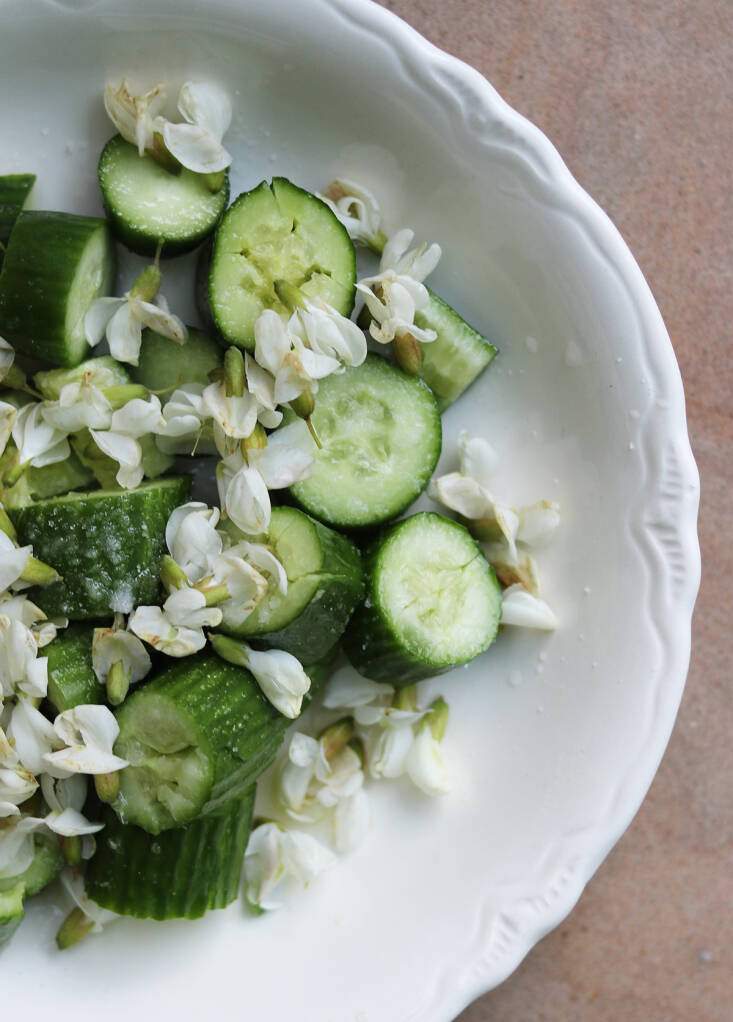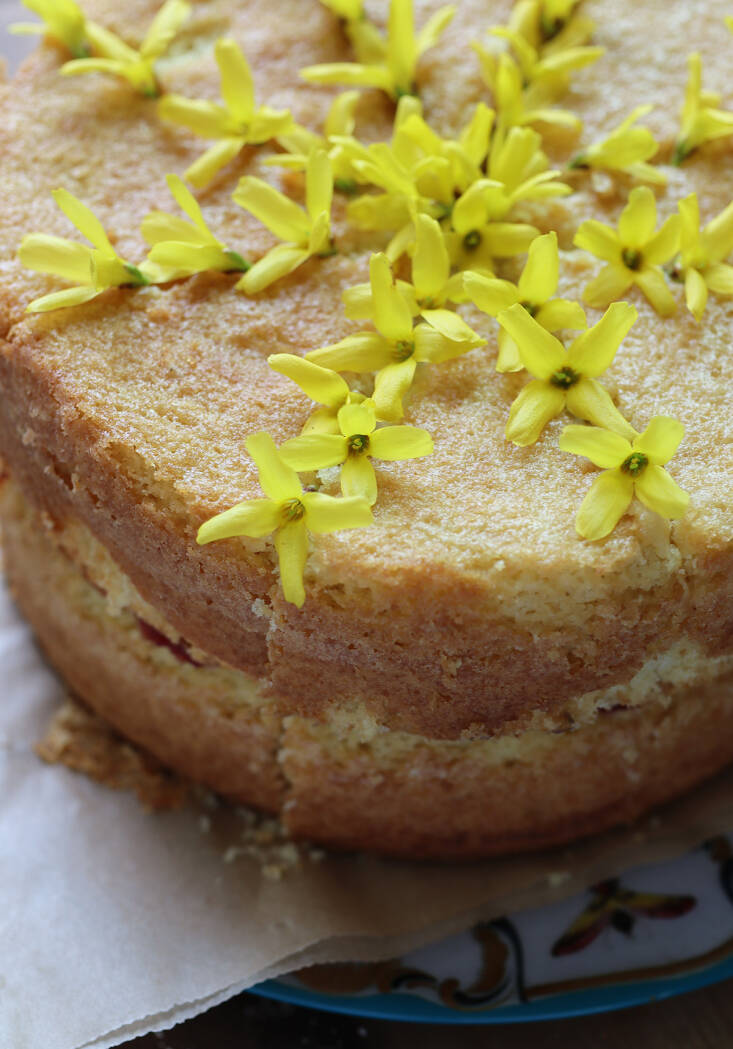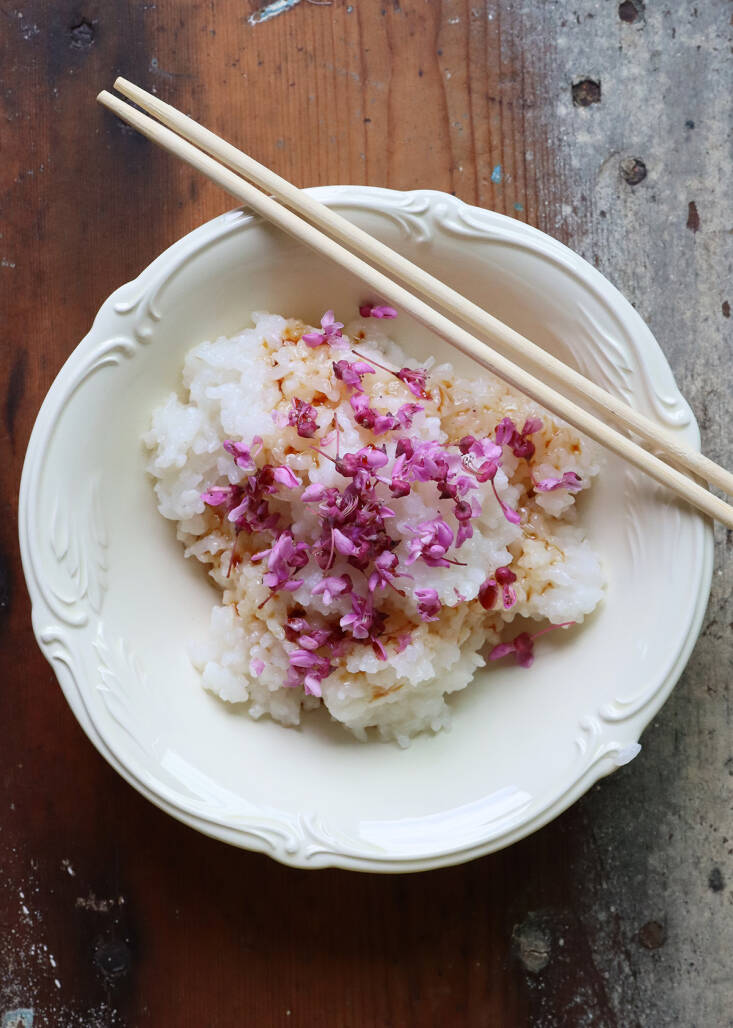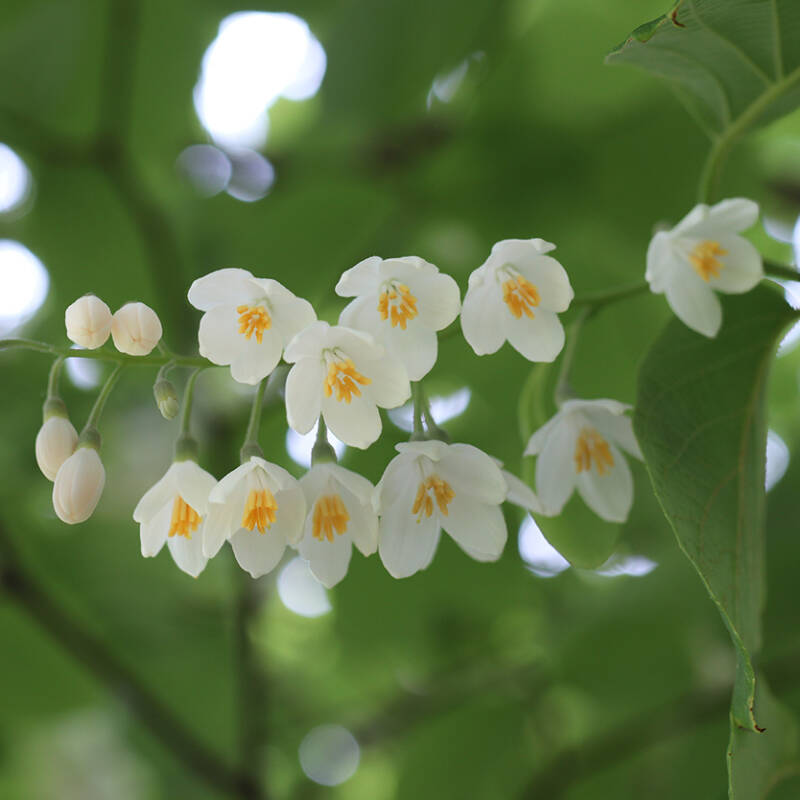For the seasonal eater, edible flowers are an ephemeral pleasure, in bud and bloom for a few weeks, at most. But why eat flowers? Because they make food beautiful; they are beautiful food. And in some cases, they can have a defining culinary presence, offering flavor and aroma beyond their obviously appealing good looks. Here is a shortlist of some of my favorite edible flowers of spring. (Summer will bring a fresh wave of blooms to grace our plates, and improve our drinks.)
Photography by Marie Viljoen.
Black Locust

Under the radar in its native North America, the edible flowers of black locust, Robinia pseudoacacia, are better known in Europe—where the tree is known as acacia—arrived in the 1600s. Hungarians embrace it as their national tree. Despite the European common name, it does not belong to the Acacia genus (usually commonly known as the mimosa clan. Confusing!). Acacia honey? It’s made by bees gathering nectar from black locust flowers. But whatever you call them, these pea-like blooms are delicious: tender and voluptuous in the mouth, and discernibly sweet.



Black locust flowers work as well in desserts and drinks as in savory dishes. Fold them into cooled couscous (along with toasted almonds) for a composed salad, toss them across crushed cucumbers, roll them into damp rice wrappers, or dip and fry them for unforgettably celebratory beignets. Or make a seasonal wine to remember the trees’ late spring splendor:

May Wine with Black Locust Flowers
Adapted from Forage, Harvest, Feast – A Wild-Inspired Cuisine
In this fortified, floral wine infusion, black locust blooms stand in for the more traditional sweet woodruff that is used in Europe. It keeps well, bottled, like a pared-down vermouth. Serve as a spritzer with ice and chilled sparkling water, on a balmy late-spring night.
- 1 bottle dry, unwooded white wine
- 1/3 cup vodka
- 3 oz black locust blossoms
- ¼ cup concentrated wisteria syrup (or substitute sugar)
- 2 pieces of lemon zest, 2 inches long
Combine all the ingredients in a large carafe and mix well. Allow to infuse overnight. Strain and chill before serving as an aperitif. (You can steam or sauté the leftover flowers gently to serve as a light side dish dressed with either olive oil and lemon, or toasted sesame oil and a splash of soy sauce.)
Brassicas

Bring on the brassicas. The edible flowers of arugula, mustards, wintercress, and wildly invasive garlic mustard are all wonderfully, piquantly delicious. Not all flowers have flavor, but brassicas (all) do. They are peppery and bright and perform best raw. Chop them by the handful into vinaigrettes and fresh green sauces, and stir them into crème fraîche, sour cream, or Greek yogurt for their horseradish-y bite.


Cherry

Cherry blossoms, sheer and gossamer-light, are a surprise if you have never tasted them. Their soft petals are infused with a sense of almond essence, and this flavor persists in their traditional pickling, a technique used in East Asia to celebrate their brief season. Simply layering cherry blossom buds (open blossoms will fall apart) with a sprinkle of sea salt in a jar, refrigerating for three days, and then covering them with a vinegar brine (the brine left from making umeboshi is recommended but not imperative) is an easy way to preserve their color and taste. A Japanese friend uses a single blossom as an eloquent flourish atop a spongy confection called karukan, made from yamaimo, Japanese yam; the tart, salty little blossom is an inspired focal point for the mild, starchy sweetness of the dessert.

Crabapple

Crabapple blossoms smell like a thundercloud on approach, filled with hail, or with snow, full of ozone and sweet freshness. And, somehow, anticipation. To capture their ephemeral scent I add crabapple flowers to white wine destined to become vermouth, soaking the blossoms in the wine overnight, before adding the fortifying botanicals.

Forsythia

As ubiquitous (and invasive) as forsythia is in early spring, it is a delight to eyes that have become used to the monotones of winter. The vivid yellow flowers are very mild in flavor but are an exceptionally easy way to introduce edible glitter to salads, to deviled eggs, to floral ice cubes, to cookies, and to cakes.


Lilac

A chance encounter with some wildly overgrown lilac shrubs on an abandoned farm in Maine, followed by a stop at a roadside farmstand selling honey on the honor system, led to what has become an annual ritual: making lilac-infused honey. Pick all the tiny flowers from each cluster of flowers, and soak them in a neutral, pale honey. Strain them out after a couple of days, and bottle. It’s very special.


Magnolia

Magnolia petals are powerfully aromatic as well as flavorful. They are reminiscent of ginger, cardamom, sometimes some menthol—each species is a little different. Spring-blooming Asian magnolias, as well as summer-blooming American species, are all edible.
Buds pickle well (turning sepia, quickly as they oxidise), and perfume good vinegar, if left to soak for days or weeks. Open petals can be used raw or cooked as a herb, and even dried, to be used as a ground spice or tea.
Read more about how to eat magnolia flowers in our earlier Tree to Table story.
Maple

Maple flowers are an unheralded source of spring pleasure. Small and tassled, or plump and lush, they are edible in their entirety. The tiniest blooms of Japanese maples are lovely scattered across a shaved salad of spring radishes while the larger, juicier clusters of sycamore and Norway maple can be treated as a vegetable in their own right. Blanch, drain, and sauté them as a topping for bruschetta, or to stir into steamed eggs. Or, you know, tempura. Never a bad idea. Serve straight from the pan, crisp and hot.
Muscari

True hyacinths (Hyacinthus) are toxic. But grape hyacinths belong to a different genus. Muscari have been eaten around the Mediterranean for a long, long time. Think Romans and ancient Greeks. I always cook them and like to strip the tiny blue beads from their stalks and incorporate them into bread dough, which they perfume, subtly, but effectively. To adorn a focaccia I blanch the whole flowers quickly, dry them, and tuck them into the living dough before baking.

Redbud

The tiny pea-flowers of redbuds (Cercis canadensis) are sweet and crunchy and make a charming garnish to complement simple food that does not detract from their form or flavor. I like adding them to steamed glutinous rice that has been stirred through with a seasoned rice wine vinegar and some drops of shoyu, and eating it up while the rice is still warm.

Wisteria

The fragrance of wisteria’s rich clusters of blossoms is delectable. While its bean-like seeds are toxic, its edible flowers are as versatile black locust’s. To make the most of their fragrance I infuse an annual wisteria syrup from open flowers (the closed ones are not yet scented), as well as a fruity, aromatic vinegar-from-scratch. The buds cure well when salted like cherry blossoms.
Edible Flower Tips
- Add flowers late to salads: oil and acid will spoil delicate petals
- For the best perfume collect flowers in the morning or evening
- To catch their scent, never boil flowers in syrup – use a cold-infusion, instead
- If you can’t use them the same day, cover unwashed flowers and keep in the fridge
See also:
- Herb Cheese: Make Your Own Boursin-Inspired Labneh
- Harbingers of Spring: 11 Early Flowers to Cheer Our Chilly Souls
- Spring Froth: Eye-Catching Umbels for the Flower Garden









Have a Question or Comment About This Post?
Join the conversation